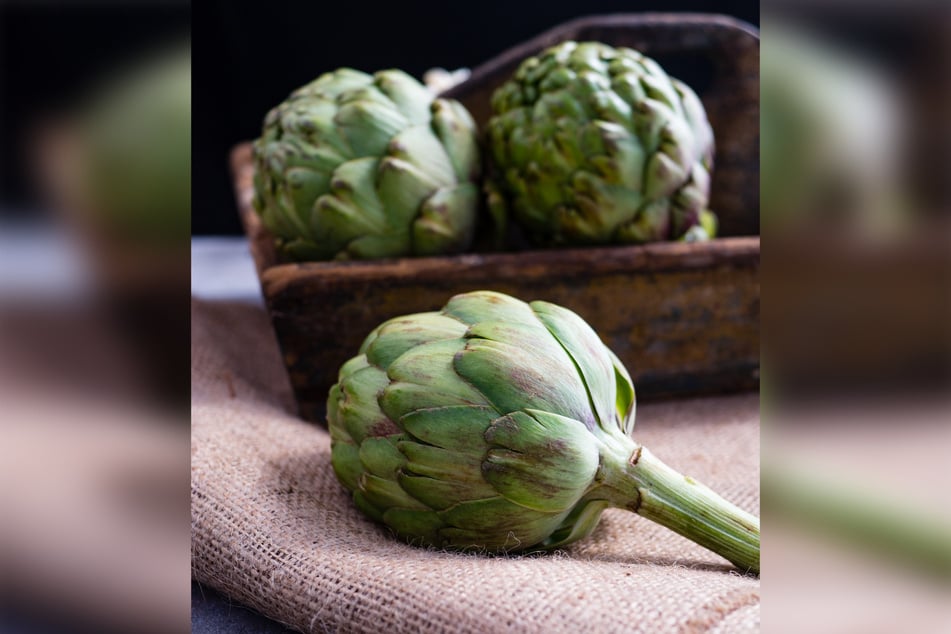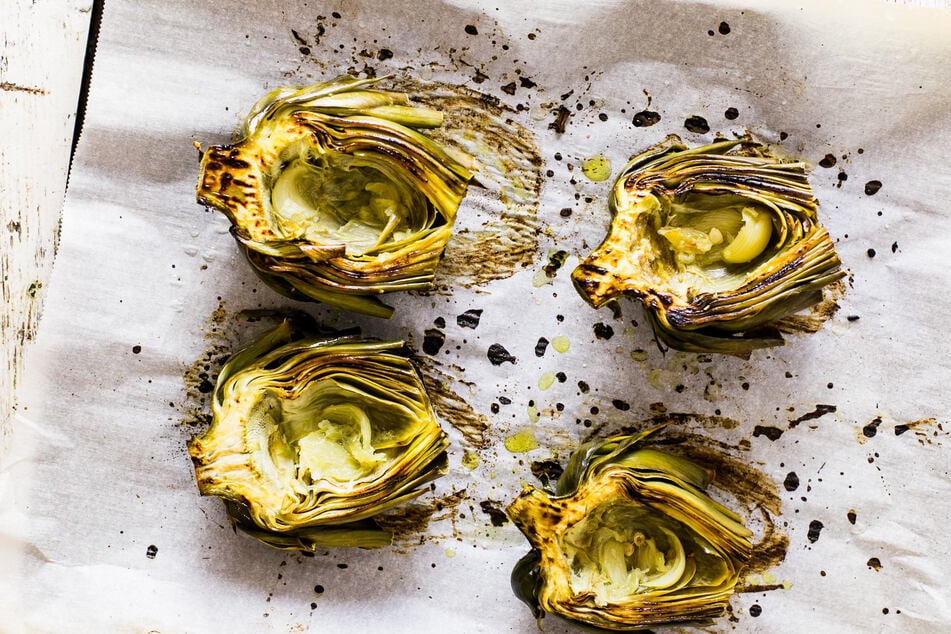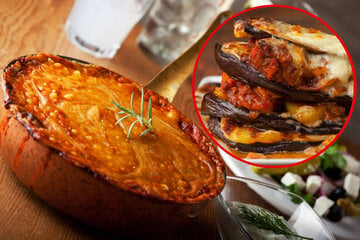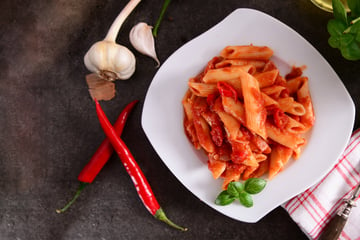How to make stuffed artichokes: An easy recipe
Stuffed artichokes are often a favorite food, but it may be overwhelming to think of making them at home. Here's an easy recipe to try on for size.

Stuffed artichokes are a family favorite when made right.
There's the ritual of sitting at the kitchen table and slowly devouring them, leaf by leaf, tongues taking in the creamy-chewy stuffing. There's a pleasure in feeling your teeth scrape out the soft inside of the bracts before biting off the bottom piece, which is like getting a teeny taste of the heart.
The right balance with stuffed artichokes is getting the stuffing components to combine with the plant's texture - moist but not soggy or oily is best.
Steaming your artichokes ensures that the stuffing is nicely moistened throughout. After a steam bath, a few minutes in the oven can dry them out just a bit, and gives the tops of the leaves a nice golden touch.
What does the tasty stuffing in this dish consist of? We love a mix of breadcrumbs, Romano cheese, garlic, parsley, salt and pepper. Panko tends to work better than "regular" breadcrumbs. On the gluten-free side, potato flakes and potato starch tend to be very gummy, but those made from rice products, give a much better result.
The real stuffing game changer is moistening it with olive oil before filling the artichokes.
Here's an-out-of-this world Sicilian-style stuffed artichoke recipe, just like grandma used to make.

How to make stuffed artichokes – and how to trim them.
This roll-up-your-sleeves-and-eat-with-your-fingers dish for a casual, intimate, at-home occasion is a family favorite. A stuffed, jumbo artichoke can in itself be a full meal for one or shared as an appetizer or snack.
Parmesan cheese can be substituted for the Pecorino Romano and gluten-free breadcrumbs can be substituted for regular - just be sure they are not made from potato flakes, which get gummy in the cooking.
Cooking Time: 2 hours 25 minutes
Yields: Serves 2 to 4
Stuffed artichokes ingredients:
1 1/2 cups panko breadcrumbs
1 cup finely grated Pecorino Romano cheese
2 tablespoons dried parsley
1 1/2 tablespoons granulated garlic
1 teaspoon Diamond Crystal kosher salt
1/4 teaspoon ground black pepper
5 tablespoons extra-virgin olive oil, plus more for drizzling
2 jumbo artichokes or 4 large globe artichokes
1 lemon
Olive oil cooking spray

Easy stuffed artichokes recipe
1.) Prepare the steamer: Set a steamer rack into a large, lidded pot, Dutch oven, or oven-proof casserole and fill the pan with water to the level of the steamer. (Or set up your regular steaming apparatus).
2.) Mix the stuffing: In a large bowl, mix together the breadcrumbs, cheese, parsley, granulated garlic, salt and pepper until thoroughly blended. Drizzle 5 tablespoons of the oil over the mixture and stir with a large spoon until the oil is uniformly distributed. The stuffing should be the consistency of grainy wet sand. Set aside.
3.) Pare the artichokes: Slice the lemon in half and rub the surface of one of the halves over your fingers. (The polyphenols in the artichokes turn black when exposed to oxygen, and they discolor the skin when they come in contact with it. The acid in the lemon will prevent the blackening of the hands as well as of the vegetables themselves.) As you work with the artichokes, rub lemon on all of the exposed edges to prevent discoloration.
Hold an artichoke in your palm with the stem facing away from you. One by one, pull the small leaves off of the stem – pull against the direction in which they grow – and, working toward the base, pull off the smaller outermost layer of leaves as well and discard. If the outer layer of leaves on the artichoke is still very small, remove that layer as well. Lay the artichoke on its side on a secured cutting board.
Using a sharp knife, cut off the stem as close to the base as possible so that the artichoke will sit flat when set upright. Cut an inch or two from the other, dry (and probably blackened) end of the stem and discard. Use a peeler or paring knife to peel the stem from end to end. Rub the stem all over with lemon and set aside.
Lay the artichoke on its side again and using a serrated knife, cut off the top third – 1 to 2 inches – of the artichoke leaves and discard. Rub lemon over the exposed edges of the leaves that remain in place. Holding the artichoke in one hand, use scissors to snip the prickly tops off of the remaining bracts at approximately the widest part of the leaf. Start with the outer layer of leaves at the base and work inward to create an alternating pattern until all of the prickly leaf tips have been removed and the leaves make an attractive graduated pattern around the body of the artichoke.
(Some people like to remove the center-most leaves as well. To do this, use a pointy-edged spoon such as a teaspoon (a grapefruit spoon with one serrated edge works particularly well for this) to dig down into the center and scoop them out from the bottom, also removing the hairy "choke" and discard. This is completely optional.) Repeat with remaining artichokes.
4.) Stuff the artichokes: Stand an artichoke upright on the cutting board. Starting from the center and working outward, use your fingers to gently pull the leaves outward to create spaces between them. Lift and hold the artichoke in one hand over the bowl of stuffing, and using the fingers of the other hand pull the leaves apart and fill the spaces with stuffing. This works best if done systematically, starting from either the inside or outside. Feel free to lay an artichoke on its side in the stuffing mixture and push stuffing into the gaps between the leaves. Use one hand to squeeze to create space and the other to fill the space. Fill each of the snipped bracts of the outer layers and as many inner leaves as the artichoke (and your patience) will allow. When it is full of stuffing, brush any straggling crumbs off the exterior so that the only crumbs visible are inside the bracts. Repeat with remaining artichokes. Depending on the size of your artichokes, you may have more stuffing than you need. Reserve any extra for another use such as stuffing other vegetables.
5.) Steam the artichokes: Bring the water in your steaming apparatus to a boil over high heat. Place the artichokes upright in the steamer basket. Drizzle each with about a tablespoon of olive oil and place the basket with the artichokes in/over the boiling water. Reduce heat to medium-low, cover and cook until very tender, about an hour and 20 minutes depending on the size and fibers of the artichokes. You should be able to easily pull out a leaf from midway between the center and the outer bracts. Check the water level every 20 to 30 minutes and add more if necessary.
6.) Bake the artichokes: Heat the oven to 350 degrees Farenheit. Once the artichokes are tender, remove the lid and lightly spray the artichokes with cooking spray (if necessary, use tongs to transfer the artichokes to a baking dish that will hold them snugly and spoon some of the steaming water into the bottom of the dish, so they are sitting in about .5 inches of liquid. It should not come up above the lowest/outermost bracts.) Slide the casserole/Dutch oven, uncovered, into the oven. Bake until the outer leaves have just turned golden, 5 to 7 minutes.
7.) Serve hot or at room temperature.
With a recipe made with lots of love, stuff your belly will stuffed artichokes and enjoy!
Cover photo: Unsplash/Tom Hermans



